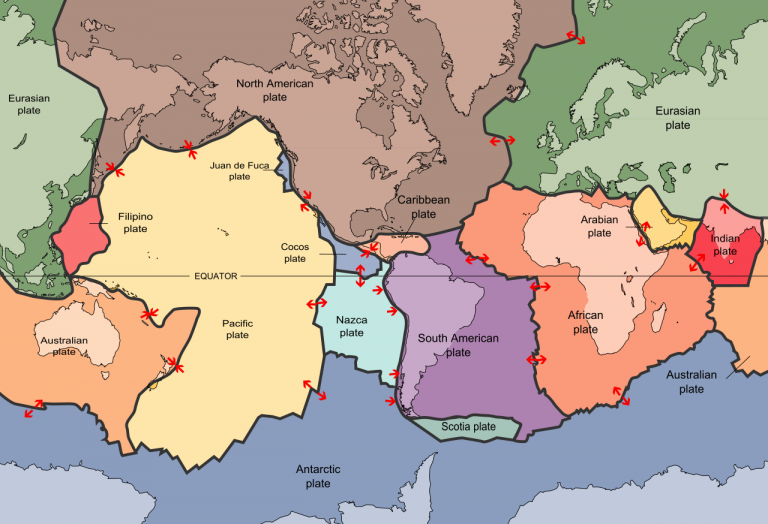Part II:- Understanding why earthquakes tsunami and volcano occur:- PLATE TECTONICS THEORY
Historically all spectacular natural phenomena like a rainbow, rising and setting of the sun on the horizon, solar and lunar eclipse, earth tremors, volcano, geysers(sulphur spring) were so awe-inspiring to the early tribal that out of the fear of the wrath of nature they thought that the best strategy for their protection and survival would be to pray and worship such sources as gods like Saturn, so people started praying when there were tremors on the earth.
In one of the ancient scientific theories, it was conceived that the Earth is a great vessel floating on the oceans, and thought that movement of the water caused earthquakes. Much other thought that giant rocks colliding in the earth’s interior or the fire caused the tremor.
In the fifth century B.C., some speculated that air became compressed in underground caverns, and eventually the pressure caused quakes. In the 18th century, it was thought that the reaction of iron and sulfur was responsible not only for earthquakes but also for volcanoes and thunderstorms.
In 1915 Alfred Wegener, the German polar explorer and meteorologist, most associate with the idea of continental drift. Wegener could see that the continents were not static, that they must have shifted over time, and that the coastlines of South America and Africa looked a suspiciously snug fit as if they were once joined together. But he couldn’t devise a convincing mechanism to drive the motion.
Plate tectonics really comes from the study of oceans. It was when we discovered the oceanic ridges, subduction zones and transform faults, and so forth since the advent of the concept of seafloor spreading, the Interest in the problem of distribution of oceans and continents was revived.
The hypothesis of plate tectonics is a unifying extended and more comprehensive version of the theory of sea-floor spreading. This is a great concept which“draws sea·floor spreading, continental drift, crustal structures and world pattern of seismic and volcanic activity together as aspects of one coherent picture.”
The term plate was first used by Tuzo Wilson in his definition of transform faults in 1965, but the hypothesis of plate tectonics was first outlined by w.J. Morgan in 1967. Basic assumptions of plate tectonics are as follows:
1. There is spreading of the seafloor and new oceanic crust is being continually created at the active mid-oceanic ridges and destroyed at trenches.
2. The area of the earth’s surface is fixed, Which means, the amount of crust consumed almost equals the amount of new crust created.
3. The new crust that is formed becomes part and parcel of a plate.
MAJOR AND MINOR PLATES
A tectonic plate is a massive, irregularly shaped slab of solid rock. Plates are generally composed of both continental and oceanic lithosphere. The lithosphere includes the crust and the top mantle with its thickness range varying between 5-100 km in oceanic parts and about 200 km in the continental areas. The plates are the inert aseismic regions bounded by narrow mobile belts which are characterized by Seismic and volcanic activity. The plate’s configuration is not related to the distribution of land and water. Plates can split or get welded with the adjoining plate.
The theory of plate tectonics proposes that the earth’s lithosphere is divided into seven major and some minor plates.
The major plates are as follows:
A. Antarctic plate – Antarctica and the surrounding ocean
B. North American plate -North America continent along with Western Atlantic floor separated from the South American plate along the Caribbean islands
C. South American plate –South America continent along with western Atlantic floor
D. Pacific plate – covers almost the entire pacific ocean
E. India-Australia-New Zealand plate – Australian continent along with Indian sub-continent and the Indian Ocean.
F. African plate –- Africa continent along with eastern Atlantic floor
G. Eurasian plate — Eurasia along with eastern Atlantic floor
Minor plates are small in areas. They are also moving in different directions like major plates. Some important minor plates are listed below:
1. Cocos plate — Between Central America and Pacific plate
2. Nazca plate — Between South America and Pacific plate
3. Arabian plate – Mostly the Saudi Arabian landmass
4. Philippine plate — Between the Asiatic and Pacific plate
5. Caroline plate — Between the Philippine and Indian plate (North of New Guinea)
6. Fuji plate- North-east of Australia.
In part III, we’ll discuss the regions of the earth which are more active like the ring of fire, etc, and will provide a list of well-known occurrences of such disasters like earthquake volcanoes and their underline causes according to the theory.

